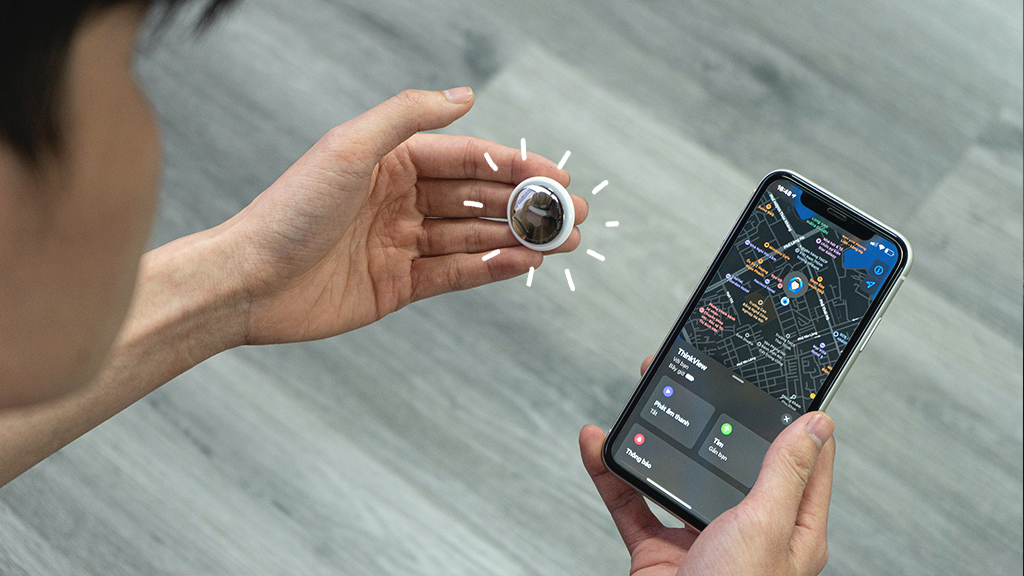Losing your keys or wallet can turn a normal day into a mini panic attack. Thankfully, Apple’s AirTag promises to make finding your items effortless.
In this blog, we’ll explore how AirTags work, their tracking range, the technologies behind them, factors affecting performance, and tips for long-distance tracking—everything you need to never lose your essentials again.
What is an AirTag?
An AirTag is Apple’s compact Bluetooth tracker designed to help you locate everyday items like keys, wallets, bags, or luggage. Once you pair it with your Apple ID, it becomes visible in the Find My app, allowing you to see where it is at any moment. AirTags don’t contain GPS. Instead, they rely on nearby Apple devices to detect and update their location.

This makes them affordable, energy-efficient, and surprisingly powerful, but it also means their performance is highly dependent on the Apple devices around them. In areas where Apple device density is high, AirTags feel almost magical. In remote areas, they behave more like basic Bluetooth trackers.
How does an AirTag track items using Apple devices?
AirTags function using a combination of Bluetooth Low Energy, Ultra Wideband, and Apple’s global Find My network. When the AirTag is near your phone, it communicates directly through Bluetooth. If you have a UWB-supported iPhone, you get directional arrows and extremely accurate tracking.
When the AirTag is far away, it doesn’t contact your phone directly. Instead, any Apple device that passes near it quietly detects its signal and sends its encrypted location to your iCloud account. The entire process is anonymous, meaning neither the nearby Apple device owner nor Apple knows the location of your AirTag.
How far can an AirTag be tracked using Bluetooth?
Bluetooth Low Energy is the primary communication layer for AirTags when they’re close to you. Indoors, Bluetooth range typically averages around 30 to 50 feet due to walls, furniture, appliances, and general interference. Outdoors, range increases significantly and often reaches 100 to 150 feet. However, these numbers vary depending on the environment.
Thick walls, metal surfaces, crowded Bluetooth environments, and wireless interference can reduce effective range dramatically. In most real-world scenarios, an AirTag will remain reliably connected if you're within 40 to 80 feet, which is enough distance to locate items in your home or around your immediate surroundings.
How does Ultra Wideband technology improve AirTag tracking accuracy?
Ultra Wideband takes tracking a step further by giving you directional, almost point-and-shoot guidance when you're close to the AirTag. This feature works only on newer iPhones such as the iPhone 11 and later. UWB doesn’t increase the AirTag’s overall range; instead, it dramatically improves accuracy within short distances.
When you activate Precision Finding, your phone displays arrows, distance indicators, and haptic feedback to help you walk directly toward the AirTag. Accuracy often falls within a few feet, and it works even when the item is hidden in tricky places like under cushions, inside bags, or behind furniture where Bluetooth alone can’t give you direction.
How do I set up and locate my AirTag on iPhone?
Tracking an AirTag from your iPhone is simple. All you need to do is open the Find My app, tap on the Items tab, and select the AirTag you want to locate. If the AirTag is near you, the app will give you options such as playing a sound or using Precision Finding if your device supports it.
If it’s not close enough for Bluetooth communication, you will instead see the most recent location detected by the Find My network. As soon as another Apple device comes into range of your AirTag, the map will update automatically.
How does Apple’s Find My network help track AirTags over long distances?
The Find My network is the backbone of long-distance AirTag tracking, powered by more than a billion Apple devices globally. When your AirTag is out of Bluetooth range, any nearby iPhone, iPad, or Mac can detect it silently and send an encrypted location update to your Find My app. This is why an AirTag placed inside a suitcase can be tracked across countries, it’s constantly being detected in airports, taxis, hotels, and other busy areas filled with Apple devices.
The network doesn’t reveal who detected your AirTag, and those devices don’t have access to any data about it. However, in sparsely populated areas with fewer Apple devices, long-distance updates may come in slowly or stop altogether.
How to Track an AirTag on iPhone Over Long Distances
Tracking an AirTag from far away relies entirely on the Find My network, not your personal Bluetooth range. When you want to see where your AirTag is, start by opening the Find My app on your iPhone. Tap the Items tab and select the AirTag you want to check. The app will immediately show you either its current location or the last spot it was detected.
If the AirTag isn’t near you, you won’t get live movement like a GPS device. Instead, you’ll see its “last seen” location. This updates automatically whenever any nearby Apple device, belonging to anyone, anywhere, passes close enough to detect your AirTag. That encrypted location ping is sent to your account, and your iPhone notifies you with the AirTag’s updated position.
To track it properly over long distances, the steps are simple:
- Open the Find My app on your iPhone.
- Tap the Items tab, where all your AirTags appear.
- Choose your AirTag, and the map will show its last known or most recently updated location.
- Wait for a new update if it’s out of range; as soon as another Apple device detects it, your iPhone will notify you automatically.
What factors affect how far an AirTag can be tracked?
Several elements influence how well an AirTag tracks. Physical barriers like thick walls, metal doors, and elevators can weaken or completely block Bluetooth signals. Wireless interference from smart home devices, routers, and Bluetooth headphones can reduce effective range significantly.
In addition, the accuracy and frequency of long-distance tracking depends heavily on how many Apple devices are around. Urban areas with high iPhone usage provide consistent, rapid updates. Rural areas with fewer devices may lead to long periods where the AirTag is undetectable.
Movement also plays a role; items passing through busy areas get updated much more often than items left stationary in isolation.
Does an AirTag keep a history of its locations?
AirTags do not show any past locations, only the current or most recently detected one. There is no timeline, no breadcrumb trail, and no map of where the AirTag has been.
This design choice is intentional to prevent misuse and unwanted tracking. An AirTag does not store any location data locally, and your iPhone only displays whatever the Find My network provides in real time.
How do AirTag sounds and notifications help me find lost items?
AirTags can emit a chirping sound whenever you trigger it through the Find My app, which helps locate items hidden nearby. This sound is useful when Bluetooth and UWB can't give you precise direction—like when your keys are buried deep inside a couch or your bag. AirTags also notify you when the battery is low or when an unknown AirTag appears to be moving with you, which is part of Apple’s built-in anti-stalking system.
How is an AirTag different from a GPS tracker?
AirTags and GPS trackers operate very differently. AirTags rely on nearby Apple devices instead of satellites, which means they don’t offer real-time, second-by-second tracking. A GPS tracker functions anywhere with a clear view of the sky and often requires a monthly subscription to maintain connectivity.
AirTags have the advantage of long battery life and seamless integration with Apple devices, making them ideal for everyday lost-and-found scenarios. However, for continuous tracking of vehicles, pets, or equipment in remote areas, a dedicated GPS tracker is more reliable.
Can I use an AirTag to track a car and how effective is it?
An AirTag can track a car over extremely long distances, even across cities or countries, as long as the vehicle regularly passes near other Apple devices. Busy roads, toll booths, city centers, and fuel stations offer plenty of opportunities for detection. However, the AirTag becomes unreliable in underground parking structures, rural regions, remote highways, or metal-lined trunks where signals cannot escape.
Anti-stalking alerts may also appear on the thief’s iPhone, making AirTags unsuitable as a theft-prevention device. They work best as a supplementary way to locate misplaced vehicles in busy areas.
Do AirTags Work With Android Devices?
AirTags do not integrate with Android for tracking. An Android user cannot view the AirTag’s location or pair it with their device. Android phones can only detect unknown AirTags that may be traveling with them as part of Apple and Google’s shared anti-stalking system.
An Android user can also tap an AirTag with NFC to view owner information if it has been marked as lost. For full item-tracking functionality on Android, alternatives like Tile or Samsung SmartTag are better suited.
Can I use an AirTag with an Android phone?
AirTags use a replaceable CR2032 coin cell battery that typically lasts around one year under normal usage. Replacing the battery takes only a few seconds and doesn’t require any special tools. The AirTag operates effectively within a wide temperature range, though extreme heat or cold can shorten battery life. Some coin cell batteries with child-safe “bitter coating” may fail to work properly because they don’t maintain electrical contact inside the AirTag.
How long does an AirTag battery last and is it durable?
AirTags are rated IP67, which means they can survive being submerged in up to one meter of water for up to thirty minutes. They handle accidental spills, rain, and day-to-day moisture without a problem. Although they are water-resistant, they are not designed for extended underwater use.
Prolonged exposure, especially in saltwater or swimming pools, can cause damage over time. Using a waterproof AirTag case is recommended if you plan to use one on luggage or items exposed to the elements.
AirTag Security
AirTags are designed with a strong focus on privacy. They use rotating Bluetooth identifiers that constantly change, preventing anyone from tracking you through the signal. All communication with the Find My network is end-to-end encrypted, meaning Apple cannot see the AirTag’s location. Anti-stalking alerts notify both iPhone and Android users if an unknown AirTag appears to be traveling with them.
How secure are AirTags and how is my privacy protected?
AirTags work across all Apple devices logged into the same Apple ID, including iPhone, iPad, Mac, and Apple Watch. You can also share an AirTag’s location with other people in your Family Sharing group, which is helpful when several people need to keep track of shared keys or luggage. If you want to transfer ownership completely, you simply remove the AirTag from your account, and the next person can pair it as if it's new.
Conclusion
AirTags can be detected within roughly 100 to 150 feet over Bluetooth, with precise short-range guidance available through Ultra Wideband. Beyond that distance, the Find My network takes over, allowing you to track the AirTag across vast distances as long as it passes near other Apple devices.
In dense, populated areas, this feels almost like real-time global tracking. In remote areas, updates may be infrequent. AirTags are powerful tools for locating misplaced items, suitcases, or vehicles in busy places, but they are not a substitute for real-time GPS tracking.








